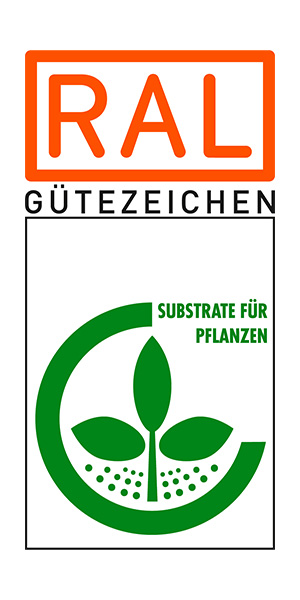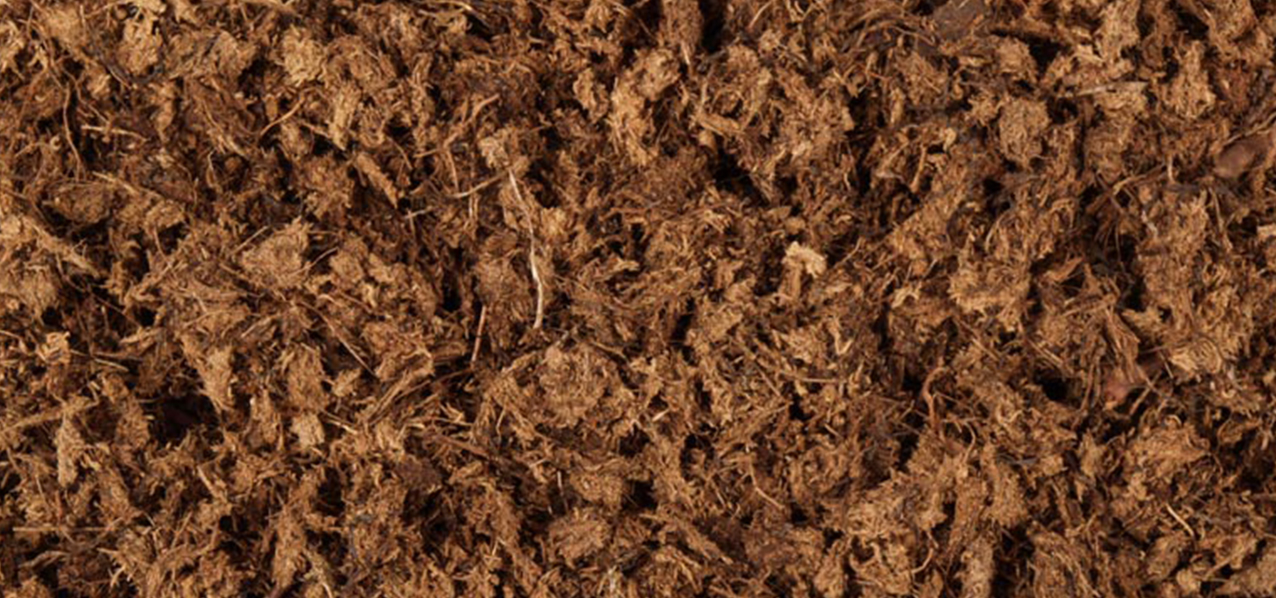Quality criteria – Raised Bog Peat
RAL-certified raised bog peat – basic material
for substrate production
Raised bog peat is the primary constituent for substrate production. It has many advantages without which today’s industrially produced substrates would not be possible. Raised bog peat forms in moors as peat moss (Sphagnum) decomposes incompletely in waterlogged conditions. It consists of 90 per cent organic matter. It is purely the result of rainwater. Very low nutrient levels make raised bog peat ideal for substrate production.
Raised bogs can grow to a thickness of several meters. The degree of decomposition decreases from the bottom to the top of the peat body, because the younger peats form in the upper part. Black peat makes up the lower part of the peat body in Germany. Originating in the period from about 5,500 until approximately 500 B.C., it is older and more highly decomposed. White peat formed between about 500 B.C. and today and is less highly decomposed. The degree of decomposition indicates to what extent the structure of the peat mosses has decomposed over time. It is given on a ten-degree humidification scale according to von POST (H value).
The properties of different peat origins differ. The reason is that the peat mosses and their accompanying plants forming the peat differed and so did the conditions for decomposition. In Germany, the bulk of raised bog peat is cut in the north-west. However, some peat deposits in the Alpine foothills are also extracted. The German substrate and soil industry today mainly uses German and Baltic peats in substrate production. Baltic white peat formed from small-leaved peat mosses. As a result, it is softer and lighter coloured with a somewhat finer structure than German peat.
Download quality criteria
The method used to extract peat has a big impact on the peat’s physical properties.
Distinction is made between the following types of peat:
White peat:
Sod peat is machine- cut and air-dried in blocks (sods). Its structure remains fully intact. After a drying period of one year with repeated restacking, the water content has dropped to approximately 50 to 60 weight per cent, allowing the peat to be processed.
Milled peat is harvested by removing a layer just a few centimetres thick from the peat body and turning it several times. Once a certain degree of dryness has been reached, the peat is collected and gathered into ridges. Milled peat has a higher percentage of fine material. Milled peat can only be extracted in good weather. The peat will dry to a water content of 50 to 60 weight per cent in a single day.
Drying is a key factor in white peat extraction. The degree of dryness determines the peat’s water capacity. If the degree of dryness is high, the peat has a lower water capacity and good drainage. If the degree of dryness is low, peat with the same degree of decomposition will have a higher water capacity. In contrast, in the case of frozen black peat, the key factor determining the peat’s water capacity is the degree of freezing.
Black peat (frozen):
Black peat is extracted using a scraper excavator and deposited on the field in a thin layer in the autumn. It must freeze hard in the winter to allow the ice to force open the peat colloids. The freezing process results in a good water capacity of at least 400 g of water per 100 g of organic mass. Once dried to a water content of approximately 65 weight per cent, the black peat can be harvested and processed in early summer.
In some cases, the peat can self-heat while being stored in heaps before processing. Self-heating will change the peat’s properties and cause the peat to produce a typical heating smell that is reminiscent of lovage. Self-heated peat may not be used in substrate production. For this reason, the soil operations constantly monitor the temperatures in the storage heaps.
Peat extraction and conservation of nature:
Environmental organisations have repeatedly criticised peat extraction in recent years, and they still do. However, nature conservation legislation is now in place in Germany to regulate peat extraction. New extraction sites may only be exploited after permission has been obtained from the local government’s nature conservation authority. These new sites comprise land that was drained around the turn of the 20th century or after World War II and has been dedicated to agricultural use since.
Intact bogs are protected by German nature conservation legislation and will not be authorised for peat extraction. These laws require a layer of at least 50 cm of natural peat to remain after peat has been extracted so that the land can be re-watered. Over the past few years, exhaustive research has been carried out on peat substitute products to reduce the consumption of peat. The valuable peat should be used as intelligently as possible.
More information can be found at
www.warum-torf.info
Quality criteria – Raised Bog Peat
RAL-certified raised bog peat – basic material
for substrate production
Raised bog peat is the primary constituent for substrate production. It has many advantages without which today’s industrially produced substrates would not be possible. Raised bog peat forms in moors as peat moss (Sphagnum) decomposes incompletely in waterlogged conditions. It consists of 90 per cent organic matter. It is purely the result of rainwater. Very low nutrient levels make raised bog peat ideal for substrate production.
Raised bogs can grow to a thickness of several meters. The degree of decomposition decreases from the bottom to the top of the peat body, because the younger peats form in the upper part. Black peat makes up the lower part of the peat body in Germany. Originating in the period from about 5,500 until approximately 500 B.C., it is older and more highly decomposed. White peat formed between about 500 B.C. and today and is less highly decomposed. The degree of decomposition indicates to what extent the structure of the peat mosses has decomposed over time. It is given on a ten-degree humidification scale according to von POST (H value).
The properties of different peat origins differ. The reason is that the peat mosses and their accompanying plants forming the peat differed and so did the conditions for decomposition. In Germany, the bulk of raised bog peat is cut in the north-west. However, some peat deposits in the Alpine foothills are also extracted. The German substrate and soil industry today mainly uses German and Baltic peats in substrate production. Baltic white peat formed from small-leaved peat mosses. As a result, it is softer and lighter coloured with a somewhat finer structure than German peat.
Download quality criteria
The method used to extract peat has a big impact on the peat’s physical properties.
Distinction is made between the following types of peat:
White peat:
Sod peat is machine- cut and air-dried in blocks (sods). Its structure remains fully intact. After a drying period of one year with repeated restacking, the water content has dropped to approximately 50 to 60 weight per cent, allowing the peat to be processed.
Milled peat is harvested by removing a layer just a few centimetres thick from the peat body and turning it several times. Once a certain degree of dryness has been reached, the peat is collected and gathered into ridges. Milled peat has a higher percentage of fine material. Milled peat can only be extracted in good weather. The peat will dry to a water content of 50 to 60 weight per cent in a single day.
Drying is a key factor in white peat extraction. The degree of dryness determines the peat’s water capacity. If the degree of dryness is high, the peat has a lower water capacity and good drainage. If the degree of dryness is low, peat with the same degree of decomposition will have a higher water capacity. In contrast, in the case of frozen black peat, the key factor determining the peat’s water capacity is the degree of freezing.
Black peat (frozen):
Black peat is extracted using a scraper excavator and deposited on the field in a thin layer in the autumn. It must freeze hard in the winter to allow the ice to force open the peat colloids. The freezing process results in a good water capacity of at least 400 g of water per 100 g of organic mass. Once dried to a water content of approximately 65 weight per cent, the black peat can be harvested and processed in early summer.
In some cases, the peat can self-heat while being stored in heaps before processing. Self-heating will change the peat’s properties and cause the peat to produce a typical heating smell that is reminiscent of lovage. Self-heated peat may not be used in substrate production. For this reason, the soil operations constantly monitor the temperatures in the storage heaps.
Peat extraction and conservation of nature:
Environmental organisations have repeatedly criticised peat extraction in recent years, and they still do. However, nature conservation legislation is now in place in Germany to regulate peat extraction. New extraction sites may only be exploited after permission has been obtained from the local government’s nature conservation authority. These new sites comprise land that was drained around the turn of the 20th century or after World War II and has been dedicated to agricultural use since.
Intact bogs are protected by German nature conservation legislation and will not be authorised for peat extraction. These laws require a layer of at least 50 cm of natural peat to remain after peat has been extracted so that the land can be re-watered. Over the past few years, exhaustive research has been carried out on peat substitute products to reduce the consumption of peat. The valuable peat should be used as intelligently as possible.
More information can be found at
www.warum-torf.info




